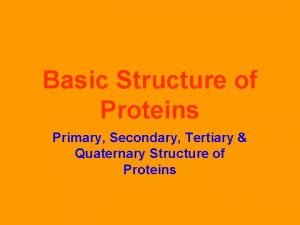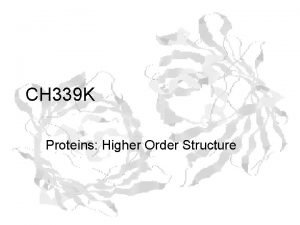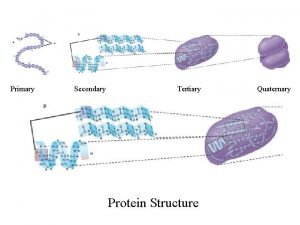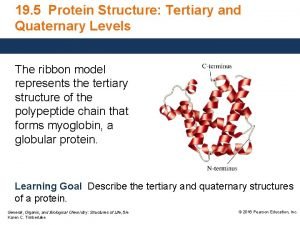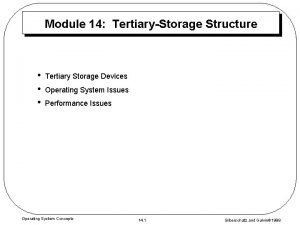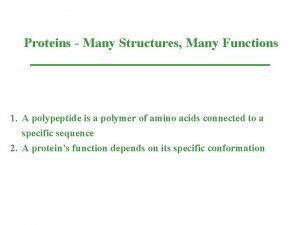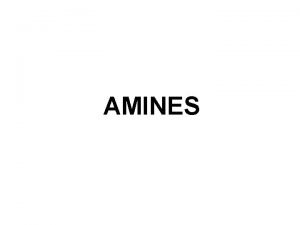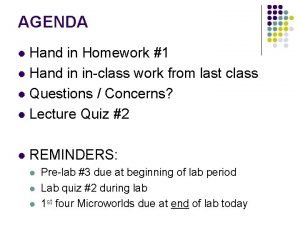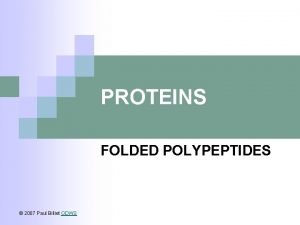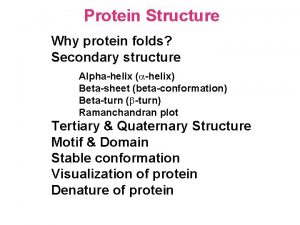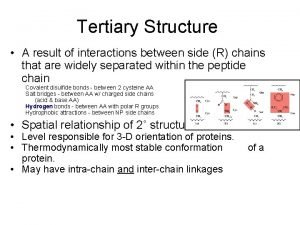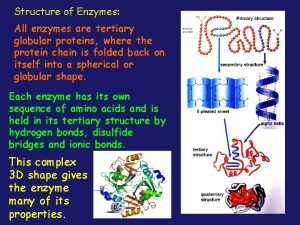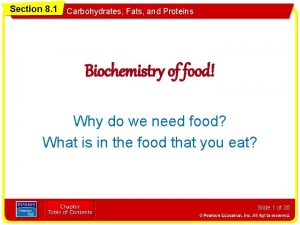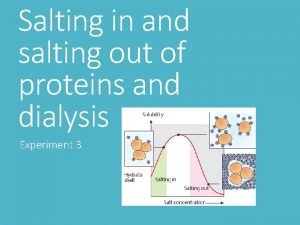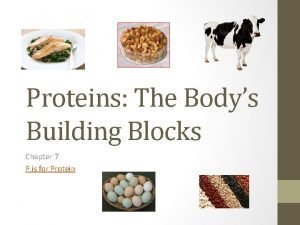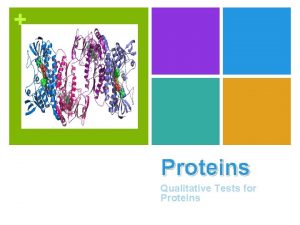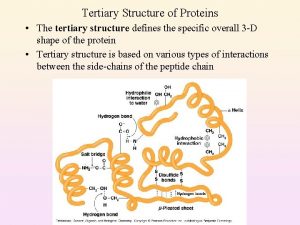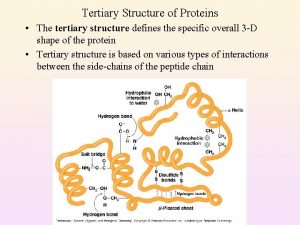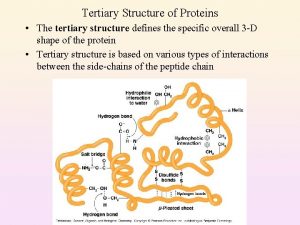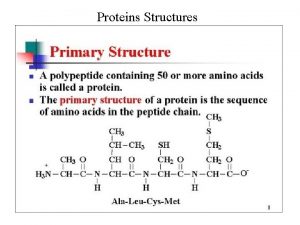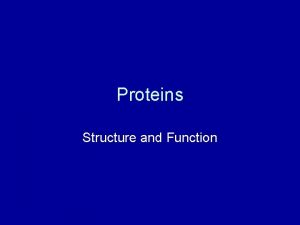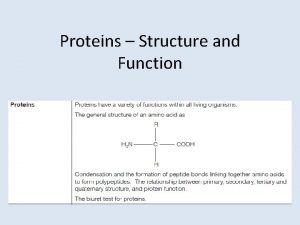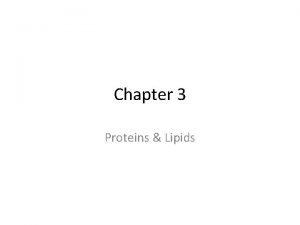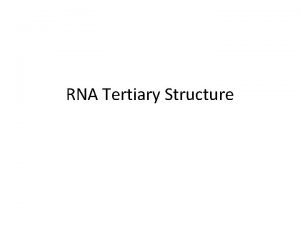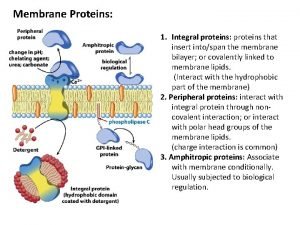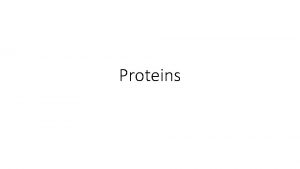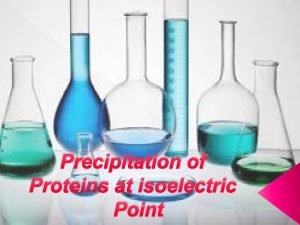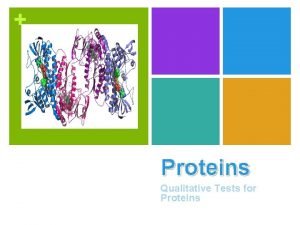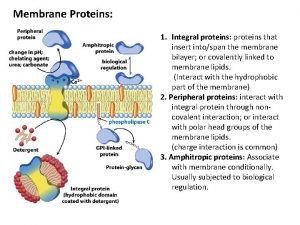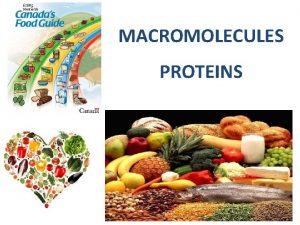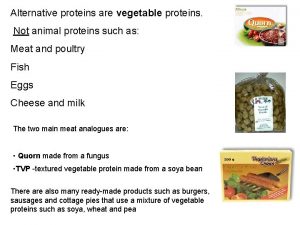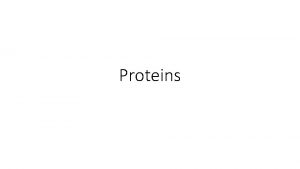3 Tertiary structure of proteins The tertiary structure



















- Slides: 19

3 - Tertiary structure of proteins The tertiary structure of a protein is its three-dimensional structure, as defined by the atomic coordinates The tertiary structure is the final specific geometric shape that a protein assumes. This final shape is determined by a variety of bonding interactions between the "side chains" on the amino acids. These bonding interactions may be stronger than the hydrogen bonds between amide groups holding the helical structure. As a result, bonding interactions between "side chains" may cause a number of folds, bends, and loops in the protein chain. There are four types of bonding interactions between "side chains" including: hydrogen bonding, salt bridges, disulfide bonds, and non-polar hydrophobic interactions.

Disulfide Bonds Disulfide bonds are formed by oxidation of the sulfhydryl groups on cysteine. Different protein loops within a single chain are held together by the strong covalent disulfide bonds.

Hydrogen Bonding Hydrogen bonding between "side chains" occurs in a variety of circumstances. The most usual cases are between two alcohols, an alcohol and an acid, two acids, or an alcohol and an amide. In the prion protein, tyr 128 is hydrogen bonded to asp 178, which cause one part of the chain to be bonding with a part some distance away. Examples of amino acid side chains that may hydrogen bond to each other: Two alcohols: ser, thr, and tyr. Alcohol and an acid: asp and tyr Two acids: asp and glu Alcohol and amine: ser and lys Alcohol and amide: ser and asn

Salt Bridges Salt bridges result from the neutralization of an acid with an amine on side chains. The final interaction is ionic between the positive ammonium group and the negative acid group. An example from the prion protein with the salt bridge of glutamic acid 200 and lysine 204. In this case a very small loop is made because there are only three other amino acids between them.

Non-Polar Hydrophobic Interactions The hydrophobic interactions of non-polar side chains are believed to contribute significantly to the stabilizing of the tertiary structures in proteins. This interaction is really just an application of the solubility rule that "likes dissolve likes". The non-polar groups mutually repel water and other polar groups and results in a net attraction of the non-polar groups for each other. Hydrocarbon alkyl groups on ala, val, leu, and ile interact in this way. In addition, benzene (aromatic) rings on phe and tyr can "stack" together. In many cases this results in the non-polar side chains of amino acids being on the inside of a globular protein, while the outside of the proteins contains mainly polar groups.

Domains The tertiary structure of many proteins is built from several domains A domain is a section of protein structure sufficient to perform a particular chemical or physical task such as binding of a substrate or other ligand. Small proteins may consist of a single domain Each domain is structurally independent of the other domains in the polypeptide chain Protein domains may be considered as elementary units of protein structure. In this representation of Pyruvate kinase, it is possible to distinguish three domains:

Domain Functions: Each domain has a separate function to perform for the protein, such as: -Can bind a small ligand -Spanning the plasma membrane (transmembrane proteins) -It might contain the catalytic site (enzymes) -DNA-binding (in transcription factors) -Providing a surface to bind specifically to another protein

Protein folding It is the physical process by which a polypeptide folds into its characteristic and functional three-dimensional structure from a random coil. -Most proteins fold spontaneously into their native conformation, even in the test tube. -Amino acids sequence of a polypeptide chain contains all the information required to fold the chain into its native, threedimensional structure. Each protein exists as an unfolded polypeptide or random coil when translated from a sequence of m. RNA to a linear chain of amino acids. -As a peptide folds, its amino acid side chains are attracted and repulsed according to their chemical properties.

The process of folding often begins co-translationally, so that the N-terminus of the protein begins to fold while the Cterminal portion of the protein is still being synthesized by the ribosome. Specialized proteins called chaperones assist in the folding of other proteins The folding process depends on the solvent, salt concentration, the temperature, and the presence of molecular chaperones. Failure to fold into native structure produces inactive proteins that are usually toxic. Several neurodegenerative and other diseases are believed to result from the accumulation of amyloid fibrils formed by misfolded proteins.

Role of chaperones in protein folding One major function of chaperones is to prevent both newly synthesized polypeptide chains and assembled subunits from aggregating into non-functional structures. chaperones are also used to prevent misfolding and aggregation that may occur as a consequence of exposure to heat or other changes in the cellular environment. In the cellular environment, newly synthesized proteins are at great risk of aberrant folding and aggregation, potentially forming toxic species. To avoid these dangers, cells invest in a complex network of molecular chaperones, which use ingenious mechanisms to prevent aggregation and promote efficient folding.

For many proteins, completion of folding requires the subsequent interaction with one of the large oligomeric ringshaped proteins of the chaperon family. These proteins bind partially folded polypeptide in their central cavity and promote folding by ATP-dependent cycles of release and rebinding. In these reactions, molecular chaperones interact predominantly with the hydrophobic surfaces exposed by non-native polypeptides, thereby preventing incorrect folding and aggregation.

Protein Denaturation is a loss of three-dimensional structure that is sufficient to cause loss of function. Denaturation involves the breaking of the non-covalent bonds which determine the structure of a protein. If proteins in a living cell are denatured, this results in disruption of cell activity and possibly cell death. Denatured proteins can exhibit a wide range of characteristics, from loss of solubility to communal aggregation. Communal aggregation is the phenomenon of aggregation of the hydrophobic proteins to come closer and form the bonding between them, so as to reduce the total area exposed to water.

How denaturation occurs at levels of protein structure - In quaternary structure denaturation, protein sub-units are dissociated and/or the spatial arrangement of protein subunits is disrupted. - Tertiary structure denaturation involves the disruption of: -Covalent interactions between amino acid sidechains (such as disulfide bridges between cysteine groups) -Noncovalent interactions between polar amino acid side-chains (and the surrounding solvent) -Van der Waals interactions between nonpolar amino acid side-chains. - In secondary structure denaturation, proteins lose all regular repeating patterns such as alpha-helices and beta-pleated sheets, and adopt a random coil configuration. - Primary structure, such as the sequence of amino acids held together by covalent peptide bonds, is not disrupted by denaturation.

A protein can be denatured, by denaturing agents: Acids Acetic acid, Trichloroacetic acid 12% in water Solvents Ethanol, Methanol…. Cross-linking reagents Formaldehyde, Glutaraldehyde Chaotropic agents Urea 6 -8 M, Guanidinium chloride 6 M Disulfide bond reducers 2 -Mercaptoethanol, Dithiothreitol (DTT).

Protein Renaturation The process of returning a denatured protein structure to its original structure and normal level of biological activity In a renatured protein, the primary structure of the biopolymer remains the same, but the protein which had been denatured gets restored back to its former native structure and is able to function as effectively as before, because a renatured protein merely undergoes the process of reversal of a denatured protein. Experimental results prove that the amino acids sequence of a polypeptide chain contains all the information required to fold the chain into its native, three-dimensional structure. Thus dismiss any remaining doubt that enzymes folds spontaneously.

Refolding of the solubilised proteins is initiated by the removal of the denaturant. To slow down the aggregation process, refolding is usually carried out at low protein concentrations, in the range of 10 -100 mg/ml. Important variables are: buffer composition (p. H, ionic strength) and Temperature Different methods for the refolding of proteins 1 - Dialysis: The most used method is the removal of the solubilising agent by dialysis. During dialysis the concentration of the solubilizing agent decreases slowly which allows the protein to refold optimally.

2 - Slow dilution: The concentration of the solubilizing agent is decreased by dilution allowing the protein to refold. Usually the dilution is carried out slowly by step-wise addition of buffer or by continuous addition using a pump. 3 - Chromatography: The solubilising agent is removed using a chromatographic step. size exclusion chromatography (e. g. gel filtration) ion exchange chromatography affinity chromatography

4 - Protein Quaternary Structure Is the assembly of several polypeptides to make a unique functional protein, stabilized through several non-covalent interactions between the R side chain of amino acids from different peptide chains. Monomeric proteins consist of a single polypeptide chain (tertiary protein). Quaternary proteins consist of two or more polypeptide chains that may be structurally identical or totally unrelated. If there are two subunits, the protein is called “dimeric", if three subunits trimeric, and, if several subunits, multimeric. The non covalent interactions that maintain the quaternary structure: Hydrogen bonds, Ionic interactions, hydrophobic interactions. . . Not all proteins show a quaternary level of organization. For having a quaternary structure: a) The protein should be formed by more than one peptide chain. b) These chains can not be attached by covalent bonds among them.

Some examples to clarify the concept: Myoglobin is formed by a single peptide chain and a heme group. Since Myoglobin is formed by just one peptide chain, it does not show quaternary structure. Insulin, for example, is formed by two peptide chains, but since these two chains are linked by disulfide linkage, insulin does not qualify as a protein with a quaternary structure. Hemoglobin is formed by four peptide chains (and four Heme groups) that are forming a unique functional protein. These peptide chains are associated through non covalent bonds between their lateral chains: Hemoglobin is the typical example of a protein with quaternary structure. Subunits may either function independently of each other, or may work cooperatively, as in hemoglobin, in which the binding of oxygen to one subunit of the tetramer increases the affinity of the other subunits for oxygen
 Primary vs secondary vs tertiary vs quaternary structures
Primary vs secondary vs tertiary vs quaternary structures Higher order structure of proteins
Higher order structure of proteins How are macromolecules separated or digested
How are macromolecules separated or digested Primary secondary tertiary
Primary secondary tertiary Primary secondary and tertiary protein structure
Primary secondary and tertiary protein structure Tertiary storage devices examples
Tertiary storage devices examples Protein tertiary structure bonds
Protein tertiary structure bonds Primary amine
Primary amine Protein tertiary structure bonds
Protein tertiary structure bonds Primary secondary and tertiary structure of protein
Primary secondary and tertiary structure of protein Tertiary structure
Tertiary structure Tertiary protein structure
Tertiary protein structure Protein pump vs protein channel
Protein pump vs protein channel Globular vs fibrous proteins
Globular vs fibrous proteins All enzymes are globular proteins
All enzymes are globular proteins Section 8-1 carbohydrates fats and proteins answer key
Section 8-1 carbohydrates fats and proteins answer key Salting out protein purification
Salting out protein purification Protein building blocks
Protein building blocks Denatured protein
Denatured protein Globular proteins examples
Globular proteins examples
